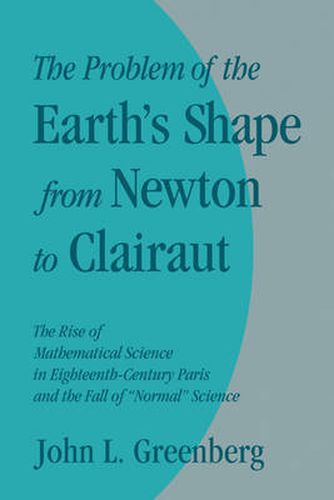Readings Newsletter
Become a Readings Member to make your shopping experience even easier.
Sign in or sign up for free!
You’re not far away from qualifying for FREE standard shipping within Australia
You’ve qualified for FREE standard shipping within Australia
The cart is loading…






This book investigates, through the problem of the Earth’s shape, part of the development of post-Newtonian mechanics by the Parisian scientific community during the first half of the eighteenth century. In the Principia, Newton first raised the question of the Earth’s shape. John Greenberg shows how continental scholars outside France influenced efforts in Paris to solve the problem, and he also demonstrates that Parisian scholars, including Bouguer and Fontaine, did work that Alexis-Claude Clairaut used in developing his mature theory of the Earth’s shape. The evolution of Parisian mechanics proved not to be the replacement of a Cartesian paradigm by a Newtonian one, a replacement that might be expected from Thomas Kuhn’s formulations about scientific revolutions, but a complex process instead involving many areas of research and contributions of different kinds from the entire scientific world. Greenberg both explores the myriad of technical problems that underlie the historical development of part of post-Newtonian mechanics and embeds his technical discussion in a framework that involves social and institutional history, politics, and biography.
$9.00 standard shipping within Australia
FREE standard shipping within Australia for orders over $100.00
Express & International shipping calculated at checkout
This book investigates, through the problem of the Earth’s shape, part of the development of post-Newtonian mechanics by the Parisian scientific community during the first half of the eighteenth century. In the Principia, Newton first raised the question of the Earth’s shape. John Greenberg shows how continental scholars outside France influenced efforts in Paris to solve the problem, and he also demonstrates that Parisian scholars, including Bouguer and Fontaine, did work that Alexis-Claude Clairaut used in developing his mature theory of the Earth’s shape. The evolution of Parisian mechanics proved not to be the replacement of a Cartesian paradigm by a Newtonian one, a replacement that might be expected from Thomas Kuhn’s formulations about scientific revolutions, but a complex process instead involving many areas of research and contributions of different kinds from the entire scientific world. Greenberg both explores the myriad of technical problems that underlie the historical development of part of post-Newtonian mechanics and embeds his technical discussion in a framework that involves social and institutional history, politics, and biography.